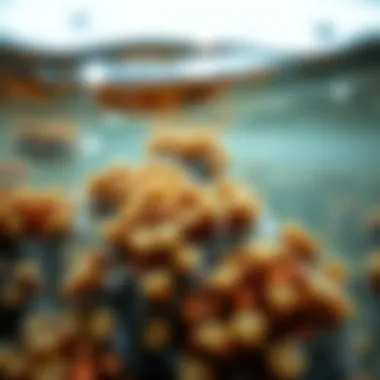Exploring the Complexities of Ocean Water


Intro
The world beneath the waves has long intrigued scientists, adventurers, and environmentalists alike. Ocean water is not just a vast expanse of liquid; it is a complex blend of various elements, showcasing intricate patterns and behaviors that significantly affect life above and below the surface. Understanding the nuances of ocean water provides insights into broader ecological dynamics and climate behavior. This article presents a structured exploration of the composition and significance of ocean water.
The focus is on salinity, whereby the concentration of salts plays a pivotal role in marine ecosystems and influences the organisms able to thrive. Coupled with temperature variations, which exhibit seasonal and geographical differences, the interdependence of these factors is crucial. Understanding them is particularly valuable for watersport enthusiasts and environmental advocates, both of whom are deeply invested in ensuring the sustainability of our oceans.
With this guide, readers can expect to discover the fascinating details behind ocean water, its impact on marine life, and the ways it shapes climatic patterns globally. Let's dive in and unravel the complexities that lie beneath the surface.
Prologue to Ocean Water
The world’s oceans are vast and filled with mysteries, making the study of ocean water a crucial topic. Understanding its myriad complexities sheds light on both the environment and our daily lives. From the smallest microorganism to the largest whale, all depend on the qualities of ocean water. This section serves as a foundation, guiding readers through key aspects of ocean water that influence marine ecosystems and human activities alike.
Understanding the Oceanic Environment
The ocean is not merely a body of water; it is a dynamic and complex ecosystem. The interplay between physical and chemical processes creates an environment that is unique. Consider how ocean currents shift, or how temperatures vary from surface to depth. Understanding these factors is vital for anyone interested in marine environments, be it from a recreational, scientific, or conservationist perspective.
In essence, the ocean acts as a living organism, constantly changing yet remarkably stable. For athletes and recreationists, this understanding can inform how they engage with water, influencing not just safety but also performance in sports like surfing and swimming. The ocean's currents can make or break an athlete's experience, so knowing how to read these can mean the difference between success and struggle.
Importance of Ocean Water
Ocean water is fundamentally important for several reasons. It plays a critical role in regulating global climate, supporting diverse forms of life, and providing resources for human communities. Here are some key points to consider:
- Climate Regulation: Ocean water heats and cools more slowly than land, moderating global temperatures. This temperature control affects weather patterns and seasons.
- Biodiversity: Over 230,000 known species reside in ocean water, with many habitats yet to be explored. Coral reefs and mangroves, for instance, act as vital nurseries for marine life.
- Economic Resources: From fishing to tourism, ocean water supports global economies. Understanding its health helps maintain these industries.
Moreover, human activities impact ocean water, with pollution and climate change threatening its quality and ecosystems. As stewards of this resource, we carry a responsibility to understand and keep it healthy. > "The sea, once it casts its spell, holds one in its net of wonder forever." This sentiment captures the deep intrinsic connection between humanity and the ocean.
Equipped with deeper insights into ocean water, athletes and coaches can design informed training regimes and safety protocols, maximizing performance while minimizing risks. As our knowledge expands, so does our ability to appreciate and protect this precious resource.
Physical Characteristics of Ocean Water
The ocean, vast and intricate, encompasses a variety of physical traits that not only shape its own identity but also influence the life forms within it. Understanding these characteristics is crucial for anyone engaged in aquatic sports or environmental conservation. Each element—from salinity to temperature and density—plays a vital role in the overall dynamics of ocean ecosystems. These characteristics not only impact marine life but also influence navigation, weather patterns, and climate. In this segment, we will delve into the specific features that define ocean water, emphasizing their significance and implications.
Salinity: A Defining Feature
Factors Influencing Salinity
Salinity is a key characteristic of ocean water, serving as a gauge for its overall health and functionality. It refers to the concentration of dissolved salts in seawater, primarily sodium chloride, but also includes other compounds. Various factors influence salinity, such as evaporation, precipitation, river inflow, and ocean currents. For instance, areas with high evaporation rates, like the Red Sea, tend to have higher salinity compared to regions where fresh water enters, like estuaries.
The distinctive feature of salinity is its ability to affect density and buoyancy, both vital for marine organisms' survival. When valuating factors influencing salinity, it becomes evident why salinity is paramount for this article. Higher salinity can create more buoyant conditions for marine life, allowing certain organisms to thrive while making it challenging for others.
Average Ocean Salinity Levels
When it comes to average ocean salinity levels, we typically see a figure around 35 parts per thousand. However, this value varies significantly due to geographic location and seasonal changes. For instance, areas near river mouths usually register lower salinity because of the influx of fresh water which dilutes salts. Conversely, in regions where the water is largely isolated from flows of fresh water, salinity can be much higher.
Understanding average salinity trends is essential for predicting marine behaviors and environments. This provides beneficial insights into ecosystem health, where deviations from average levels can indicate underlying issues. A unique aspect of average ocean salinity levels is its relationship with climate change, as global warming may alter these averages over time due to changes in evaporation and precipitation cycles.
Temperature Variations
Temperature variations in ocean water are paramount as they directly influence the biological and physical processes occurring within the marine environment. They are not homogeneous and can greatly differ depending on depth and location.
Surface vs. Deep Ocean Temperatures


Surface temperatures can experience significant fluctuations throughout the year, often influenced by atmospheric conditions such as winds and solar radiation. In contrast, deep ocean temperatures are much more stable and typically hover around 4 degrees Celsius. The difference in temperatures between these layers is vital for understanding ocean dynamics.
The critical characteristic of this temperature disparity is the way it creates thermal stratification, which profoundly impacts nutrient distribution and marine life. In shallow coastal areas, warmer surface waters can foster greater productivity as photosynthesis goes into overdrive, while deeper zones, cooler and darker, can host unique ecosystems distinctly adapted to muted light and lower temperatures. This contrast underlines the importance of understanding surface and deep ocean temperatures for anyone interested in ocean dynamics.
Impact on Marine Life
Temperature variation is more than just a statistic; it significantly impacts marine life. Each species has adapted to thrive within certain temperature ranges, influencing breeding, feeding, and migration patterns. For instance, warmer waters can lead to coral bleaching, a phenomenon where corals lose their vibrant colors and health due to stress from high temperatures.
The unique aspect to consider here is that temperature can serve as an indicator of broader environmental changes. Marine biologists often monitor ocean temperatures to gauge ecosystem health and predict shifts in species distributions. Understanding temperature’s role in marine life adaptations can help inform conservation efforts and sustainable practices.
Density and Stratification
Ocean density is influenced heavily by both salinity and temperature, making it a foundational aspect of oceanography. These elements interact to create distinct layers within the ocean—an essential focus for understanding marine currents and ecosystems.
How Density Affects Ocean Currents
Density differences drive ocean currents, forming a global conveyor belt that regulates climate and nutrient distribution. Warmer, fresher water tends to stay on the surface, while colder, saltier water sinks, creating currents that traverse the oceans. This stratification plays a crucial role in mixing nutrients and distributing heat across the planet.
Recognizing how density influences ocean currents is crucial for understanding climate patterns. The unique feature here is that these currents can affect everything from weather in coastal areas to global climate systems over time. Thus, knowledge of density and currents is instrumental for athletes and coaches who depend on currents for their activities.
Thermal Stratification Explained
Thermal stratification refers to how different layers of ocean water separate based on temperature differences. Typically, the surface layer is the warmest, followed by a thermocline, where temperature drops rapidly, leading to the cold deep sea layer. This stratification influences not only marine life but also the mixing of nutrients and gases.
The characteristic of stratification is that it can seasonally change, affecting ecosystems and weather patterns. During summer, the warm surface layer may limit nutrient supply to deeper layers, influencing biological productivity. Conversely, during winter, the cooling of surface waters can result in mixing, fostering nutrient distribution. The unique feature of thermal stratification can serve as a double-edged sword for ecosystems, providing necessary stability but sometimes causing nutrient limitations.
Chemical Composition of Seawater
Understanding the chemical composition of seawater is essential, as it encompasses the very building blocks that allow marine ecosystems to thrive. Sea water isn’t just O; it is a rich amalgamation of various elements and compounds, each serving a unique purpose. From supporting life to influencing weather patterns, the composition of seawater plays a pivotal role in ecological dynamics.
Key Elements and Compounds
Sodium Chloride and Beyond
Sodium chloride, or table salt, might be the first thing that springs to mind when discussing seawater. But its role transcends mere seasoning; it's crucial for maintaining osmotic balance in marine organisms. This compound constitutes about 85% of the dissolved salts in seawater. Salt ions contribute to the conductivity of ocean water, making it an electrical conductor, an important aspect for species that rely on electrical signals for navigation and communication.
One key characteristic of sodium chloride is its ability to dissolve readily in water, a feature that enables it to be uniformly distributed in oceans. Its presence impacts not just individual marine life, but also global systems like weather patterns. For example, ocean currents, which transport heat across the planet, are partly driven by salinity gradients influenced by sodium chloride concentration.
Though beneficial, excess sodium chloride can make environments inhospitable; for instance, increases in salinity due to evaporation in coastal areas can stress certain marine species.
Trace Elements and Their Roles
While sodium chloride grabs the spotlight, it's the trace elements that often go unnoticed but are incredibly vital for life in the sea. Elements like zinc, copper, and selenium, although present in very small quantities, play significant roles in biological processes. For instance, zinc is essential for immune function in many marine species, while copper is a crucial part of the respiratory proteins in various organisms.
These trace elements act as cofactors for enzymatic reactions, making them indispensable for metabolic processes. Their concentration in oceans can indicate the health of the ecosystem. An unusual spike or drop in these elements could hint at underlying problems such as pollution or habitat change. However, they can also be detrimental in excess, causing toxicity to aquatic life.
pH Levels and Ocean Acidification
Current pH Trends
An essential piece of the puzzle in understanding ocean chemistry is pH levels. The current average pH of ocean water hovers around 8.1, which is slightly alkaline. However, straying from this balance can lead to significant changes in marine life. Since the Industrial Revolution, increasing levels of carbon dioxide in the atmosphere have resulted in more CO2 being absorbed by oceans, leading to acidification. Recent studies indicate that ocean pH could decrease to 7.8 by the end of this century if trends continue, creating a more acidic environment.
A lower pH can harm calcifying organisms like corals and shellfish, which rely on calcium carbonate to form their shells. Such changes cascade through ecosystems, affecting species hierarchy and biodiversity. A nuanced understanding of these trends helps marine researchers and conservationists devise strategies for mitigation.


Consequences of Acidification
The implications of ocean acidification ripple through marine ecosystems. Decreased pH affects marine organisms in various ways. A prime example is the impact on coral reefs, often dubbed the "rainforests of the sea." When acid levels rise, the carbonate ions necessary for coral growth diminish, leading to weaker reef structures and ultimately, habitat loss for countless marine species.
Moreover, acidification alters fish behavior, impeding their ability to detect predators. These changes can shift population dynamics, allowing certain species to thrive while others decline or even become extinct. Ensuring the health of our oceans requires awareness of these consequences, as they directly tie back to human activities like fossil fuel consumption.
In summary, the chemical composition of seawater is rich and complex, playing a fundamental role in ocean health, life sustenance, and climate regulation. A deeper understanding of these properties equips athletes, coaches, and recreationists alike with the knowledge to appreciate the delicate balance of marine life.
The Role of Ocean Water in Ecosystems
Understanding the role of ocean water in ecosystems goes well beyond surface observations. It's a complex interplay between various elements that creates a thriving environment for countless forms of life. These interactions not only support marine life but also govern climate and weather patterns across the globe. This section carefully examines how ocean water is intricately woven into the fabric of ecosystems, impacting everything from biodiversity to climate stability.
Supporting Marine Life
Habitat Formation
Habitat formation under the sea is a cornerstone for all marine ecosystems. Ocean water serves as a home for myriad species, from vibrant coral reefs to abyssal plains teeming with life. Corals, for example, are often referred to as the rainforests of the sea due to their biodiversity. They provide structure and shelter for various organisms, creating a microhabitat that sustains both small fish and larger predators.
The key characteristic of habitat formation is its ability to create safe havens for species during breeding and juvenile development. This protection is critical because many marine species are vulnerable during early stages. The advantage of these habitats is they boost local biodiversity, enabling an ecosystem to thrive by supporting various species that all interact in unique ways.
However, not all habitat formations are equal. For example, artificial reefs may not fully replicate the intricate ecosystems found in natural reefs. These unique features of habitat formation showcase both the strength and fragility of marine ecosystems. While they can enhance local biodiversity, such man-made structures can also introduce novel challenges that native species must adapt to, which does add an interesting layer of complexity to their survival.
Nutrient Cycling
Nutrient cycling is another fundamental aspect of ocean water's role in ecosystems. The ocean acts as a vast reservoir of nutrients that support marine life. For instance, phytoplankton, microscopic plants in the ocean, are essential contributors to the food chain, converting sunlight into energy and releasing oxygen as a byproduct. This process lays the groundwork for nearly all marine life.
The key characteristic of nutrient cycling is the continuous movement of nutrients through various biological and physical processes. These biological activities ensure a constant supply of nutrients, which is beneficial for sustaining marine ecosystems. The unique feature of nutrient cycling highlights how waste and decomposition factors into this balance. Without effective cycling, nutrient depletion or excess can disrupt ecosystems, leading to harmful algal blooms or dead zones where life cannot thrive.
This inclusion of nutrient cycling emphasizes the interdependencies between species and their environments, showing how even the smallest organisms play a vital role in maintaining the health of the ocean.
Impact on Climate and Weather Patterns
Ocean water's influence extends beyond ecosystems, profoundly affecting climate and weather patterns across the globe. This interplay creates a dynamic system that governs everything from rainfall patterns to seasonal temperature changes.
Ocean Currents and Their Influence
Ocean currents are significant players in this climatic chess game. They transport warm and cold water across vast distances, regulating temperatures and influencing weather systems worldwide. An example of this is the Gulf Stream; it carries warm water from the Gulf of Mexico towards Europe, raising temperatures there compared to regions at similar latitudes.
The key characteristic of ocean currents is their potential to moderate climate impacts. By redistributing heat, they affect agricultural productivity and water availability in coastal regions. Given their importance, understanding currents is a beneficial choice for anyone interested in climate science.
However, ocean currents also face threats from climate change. Alterations in the global temperature can disrupt these currents, leading to unpredictable weather patterns. Such interference can result in enhanced storms or prolonged droughts in various regions, posing significant challenges to both natural ecosystems and human societies.
Heat Distribution Across the Globe
Heat distribution by ocean water relies heavily on its ability to absorb, transport, and release heat efficiently. This process affects global climate stability and weather conditions. As ocean water warms, it affects evaporation rates and precipitation patterns, contributing to changes in our climate.
The key characteristic of heat distribution is that it serves as a thermal regulator for the planet. Without this intricate system, we would experience much harsher temperature fluctuations on land, altering ecosystems and agricultural viability.
However, the rise in sea temperatures can lead to negative consequences, such as coral bleaching events and shifts in marine biodiversity. The unique feature of heat distribution illustrates the delicate balance of sustaining life while also facing the consequences of human-induced climate change. Acknowledging these effects is crucial for developing effective strategies in climate adaptation and mitigation.
Human Interaction with Ocean Water


The oceans are much more than just vast bodies of saltwater; they are integral to human life on multiple levels. From recreational activities to critical ecological roles, our relationship with ocean water shapes both our culture and environment. Understanding this dynamic is not merely an academic endeavor but a crucial step in fostering a sustainable future.
Pollution and Its Effects
Types of Marine Pollution
Marine pollution is a pressing issue that affects ocean water quality and overall health. Various kinds of pollution stem from human activities, and recognizing them is crucial for effective mitigation. The most prevalent types include:
- Plastic Pollution: This includes everything from large fishing nets to tiny microplastics. Plastics don’t decompose easily and can end up harming marine life, causing everything from blocked stomachs to sick marine mammals.
- Chemical Runoff: Fertilizers and pesticides used in agriculture can wash into oceans, leading to nutrient pollution. This spurs harmful algal blooms that suffocate marine ecosystems.
- Oil Spills: These catastrophic events can devastate marine environments, coating animals and causing extensive harm to fisheries and tourism.
Each of these pollutants contributes to a broader decline in ocean health, making it essential to understand their sources and effects.
Long-Term Consequences for Ecosystems
The long-term consequences of continued pollution in marine environments can be grave and irreversible. One key consequence is the disruption of marine food webs. When pollutants enter the ocean, they can accumulate in the tissues of marine organisms, leading to bioaccumulation.
- Bioaccumulation: Small fish ingest toxins, which then accumulate in their systems. When larger predators eat these fish, the toxins increase exponentially, impacting species health and reproduction.
- Loss of Biodiversity: Species that cannot adapt quickly face extinction. A decrease in biodiversity hampers ecosystem resilience, which is crucial for adapting to environmental changes, including climate change.
"The delicate balance of marine ecosystems is increasingly jeopardized by human actions, requiring urgent attention and sustainable practices."
Conservation Efforts
Global Initiatives
Efforts to address ocean pollution are happening at both local and global levels. Global initiatives such as the United Nations 2030 Agenda for Sustainable Development aim to forge a worldwide response to marine conservation challenges. Through efforts like the "Clean Seas" campaign, countries are rallying to reduce plastic pollution. These initiatives are vital because they foster international cooperation and funding for ocean health programs.
- Cooperation: Countries sharing oceanic borders must work together, as pollution doesn’t recognize national boundaries.
- Research Funding: Global cooperation often brings together resources for research into pollution impacts, thus enabling better-data driven decisions for conservation.
Local Actions in Watersports Communities
Local actions are equally significant in driving change. Watersports communities often serve as incredible platforms for conservation. For instance, beach cleanups organized by diving or surfing clubs showcase a commitment to preserving ocean environments.
- Community Engagement: Local initiatives grant communities a direct role in protecting their aquatic surroundings. When community members feel a sense of ownership, their conservation efforts amplify.
- Educational Programs: Many watersports organizations incorporate education about marine ecosystems, thus raising awareness of pollution and inspiring action.
The interplay between human activity and ocean conservation illustrates the responsibilities we hold. By understanding the intricacies of ocean water and taking action against pollution, we can ensure a vibrant sea for future generations.
Culmination: The Future of Ocean Water
As we look ahead, the vitality of ocean water emerges as a pivotal subject for our world’s ecological and social dynamics. Understanding the intricacies of ocean water is more than just an academic pursuit; it’s about grasping how our actions ripple across vast marine landscapes. From the calming tides that cradled early civilizations to the complex ecosystems that now face multifaceted threats, the future of ocean water is inextricably linked to humanity's choices and behaviors.
Sustainability Challenges
The stewardship of ocean water comes with its fair share of hurdles. One significant challenge is the increasing temperature due to global climate change. It’s not just a matter of warming waters; changing temperatures influence the entire oceanic health, affecting coral reefs and myriad species that depend on stable conditions. Additionally, pollution from land has turned once-pristine patches into debris-laden zones. Plastic waste, chemical runoffs, and nutrient overload contribute to dead zones where marine life struggles to survive.
"More than 80% of marine pollution originates from land-based activities."
These sustainability challenges are not insurmountable, but they require collective action. It involves community initiatives, stronger regulations on pollutants, and promoting practices to conserve resources. Education also plays a key role, where spreading awareness about the importance of protecting marine environments can spark grassroots movements.
The Ongoing Importance of Research
In addressing these sustainability challenges, the significance of continued research cannot be overstated. Scientific endeavors focused on oceanography and marine biology are crucial to understanding not only the current state but also the trajectory of ocean water health. This body of knowledge allows for formulating new strategies to mitigate negative impacts.
Insights gained from research enable ocean scientists to better predict how various factors interplay within the ocean's intricate systems. For instance, studies on ocean acidification shed light on how rising CO2 levels disrupt carbonate structures crucial to marine organisms. Furthermore, monitoring changes in salinity and nutrients can show early signs of shifts in ecosystem balance.
Investing in research guarantees that we are not throwing darts in the dark. By understanding ocean dynamics better, we can make informed decisions that ensure the longevity and health of marine ecosystems. Collaborative efforts across nations and organizations amplify these endeavors, leading to a more robust approach to confronting the complexities surrounding ocean water.
In summary, the ocean water cannot be overlooked; it’s an invaluable resource requiring our vigilance and action. As athletes, coaches, and recreationists engaging with water-based activities, recognizing our role in this intricate web can pave the way for a healthier future, both for ourselves and the oceans we cherish.







